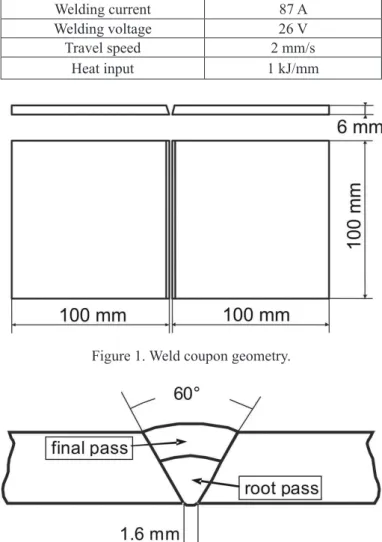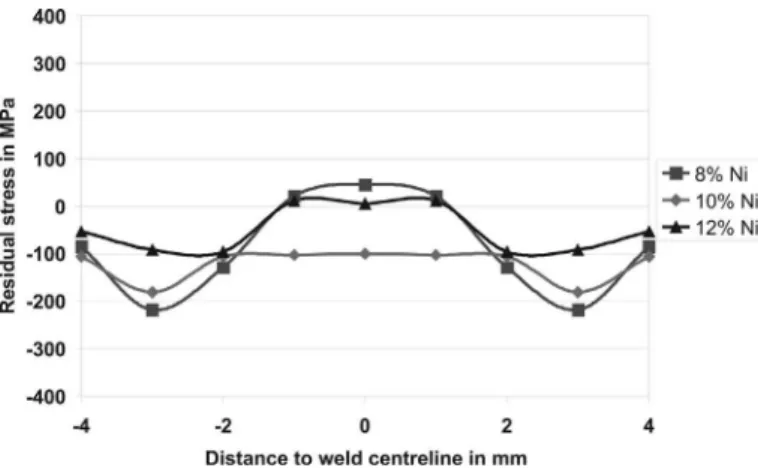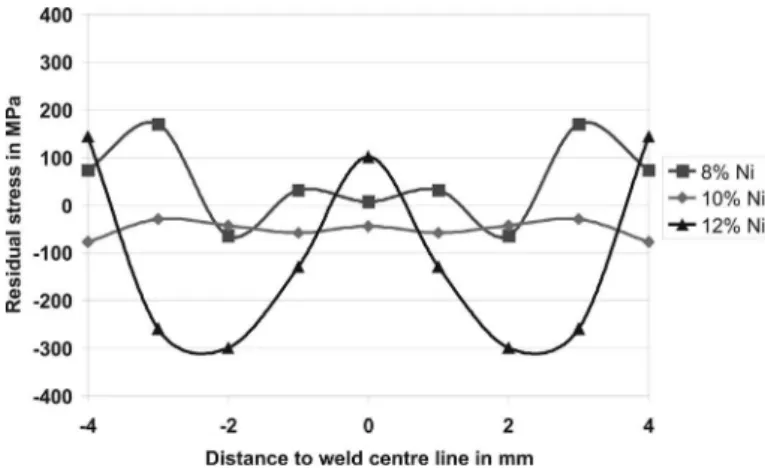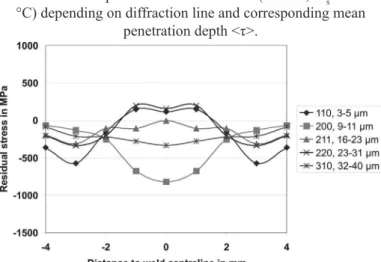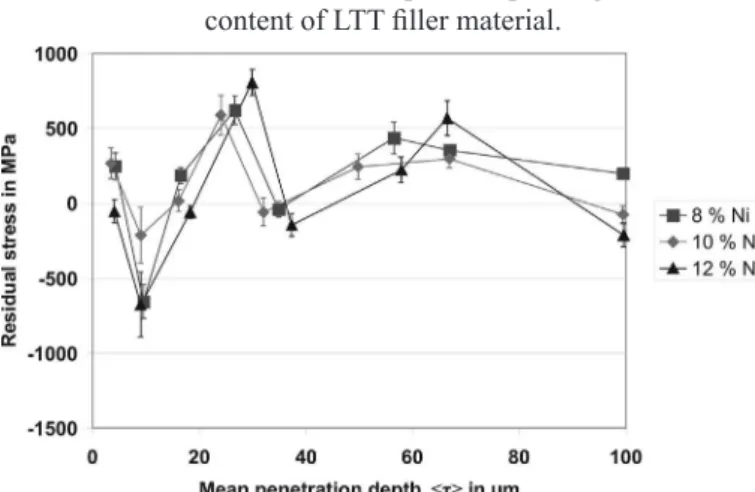(Recebido em 03/08/2008; Texto Final em 18/12/2008).
(Tensões Residuais de Soldagem em Materias de Baixa Temperatura de transformação (BTT))
Thomas Kannengiesser1, Arne Kromm1,
1Federal Institute for Materials Research and Testing (BAM), Unter den Eichen 87, 12205 Berlin, Germany
e-mail: Thomas.Kannengiesser@bam.de
Abstract
For the safety and cost eficiency of welded high-strength steel structures, precise knowledge of the level and distribution of welding- and cooling-speciic stresses and residual stresses is essential, since they exert a decisive inluence on strength, crack resistance, and inally on the bearable service load. This paper presents innovative iller materials, of which the phase transformation temperature was
deliberately adjusted via the chemical composition. The transformation behaviour of these martensitic Low Transformation Temperature
(LTT-) iller materials shows direct effects on the local residual stresses in the weld and the HAZ. These effects can purposefully be exploited to counteract the thermally induced shrinkage of the material and to produce signiicant compressive residual stresses in the weld. Comparative welding experiments were carried out on 690 MPa high-strength base materials using various LTT-iller materials.
High energy synchrotron radiation was used for residual stress measurement. Particularly the use of high energy synchrotron radiation makes it possible to detect the residual stress condition fast without destruction of material. Thereby, residual stress depth gradients can be determined simultaneously without removing material. In steel, gradients of up to 150 µm can be resolved in such a way. Furthermore, the application of high energy radiation permits determination of residual stresses of any available residual austenite contents. Results
show signiicant dependence of transformation temperatures on the resulting residual stress level and distribution.
Key-words: Phase speciic residual stresses; phase transformation; Low Transformation Temperature iller wire; energy dispersive diffraction; high strength steel.
Resumo: Para a segurança e eiciência do custo de estruturas soldadas de aço de alta resistência, um conhecimento preciso do nível
e distribuição das tensões residuais de soldagem é essencial pois estas exercem uma inluência decisiva na resistência à issuração e na carga suportada em serviço. Este artigo apresenta metais de adição inovativos nos quais a temperatura de transformação foi deliberadamente ajustada pela composição química. A transformação destes metais de adição martensíticos causa um efeito direto nas tensões residuais nas zonas fundida e afetada pelo calor (ZAC). Estes efeitos são explorados para contrabalancear a contração térmica do material e produzir tensões residuais compressivas na solda. Testes comparativos de soldagem foram feitos em um metal base de alta resistência de 690 MPa usando diferentes metais de adição de BTT. Radiação sincrótona de alta energia foi usada para medir as tensões residuais. O uso desta radiação permite medir as tensões rapidamente e de forma não destrutiva. Os resultados mostram uma dependência signiicativa da temperatura de transformação no nível e distribuição das tensões residuais resultantes.
Palavras-chave: Tensões residuais, transformação de fase, baixa temperatura de transformação, metal de adição, difração, aço de alta
resistência.
Introduction 1.
Safety of welded higher-strength steel structures calls for precise knowledge of the welding residual stresses which profoundly inluence the crack resistance and the service load. The fact that the iller material, apart from constructional design and purposeful heat control, may contribute signiicantly to residual stress reduction is relected in the studies conducted by [1-4] concerning the development of a high-strength iller material with correspondingly lowered martensitic transformation temperature (Low Transformation Temperature (LTT) iller material). First investigations into the effect of this iller material
on the welding residual stresses were recently carried out also by [5-8]. However, so far no concrete quantiications of residual stress distributions in welded butt joints are available.
This welding residual stress reduction due to low phase transformation temperatures can in principle be explained in the following way. Since the thermal expansion coeficient of austenite is higher than that of ferrite, volume expansion due to the phase transformation at low temperatures is higher. Following Bhadeshia [9], high shrinkage compensation of the fcc lattice (Re ⇓) during cooling, and hence lower stress rise,
must additionally be assumed, since the evolution of higher stress is limited by the shrinkage due to the lower yield point of austenite compared to ferrite. In the bcc lattice (Re ⇑), by
volume change compared to reconstructive transformation of ferrite or pearlite due to a dilatation normal and a large shear strain component parallel to the habit plane in case of displasive transformation. Also, displacive transformation at low temperatures favours crystollagraphic variant selection due to higher acting stresses at these temperatures, leading to a transformation texture and anisotropic dimensional changes from what larger stress reductions can be expected. Furthermore, the inish temperature of the transformation is important hence subsequent thermal contraction gives rise to tensile stresses again.
For these reasons, minimizing of the residual stresses during welding is essential, i.e. lowest possible transformation temperatures have to be realized via alloy concepts with respective weldability, apart from heat control during welding (cooling rate). The use of higher-strength iller materials with correspondingly lowered martensitic transformation temperature may inally have positive effects also on the cold cracking
resistance, as for example with the help of Mf-temperatures
below room temperature with respective proportions of retained austenite.
The investigations carried out in this study using innovative
high-strength iller materials with speciically lowered Ms/Mf
-temperatures have demonstrated that different transformation temperatures may signiicantly affect the welding residual stresses. In order to characterize the effect of lowered martensite start temperatures on the welding residual stresses, it was possible for the irst time to apply high-energy synchrotron radiation. In this analysis, differentiation was made between the phase-speciic residual stresses in the martensitic and austenitic phase.
Experimental 2.
Material 2.1.
Investigations in this work focused on three selected LTT iller materials with variation of the nickel content between 8 % and 12 % in steps of 2 %. Table 1 shows the nominal composition
of LTT welding material and their Ms - temperatures determined
by thermal analysis as presented in [11].
Table 1. Nominal composition of weld metal and Ms – temperatures.
LTT iller
No. C Alloying elements in weld metal in Wt.%Ni Cr Mn Si Ms - temperatures in °C [11]
1 0.04 8 10 0.7 0.4 184
2 0.04 10 10 0.7 0.4 90
3 0.04 12 10 0.7 0.4 39
Table 2 represents the chemical compositions of the investigated welds measured by spark source spectroscopy. A slight decrease in chromium and nickel content compared to the nominal composition was found. In contrast, the weld metal experiences manganese and
above all carbon dilution. These changes should barely have any effect on the Ms - temperature and, hence, the decrease in nickel and
chromium is balanced by dilution of carbon which strongly inluences the Ms - temperature.
Table 2. Chemical composition of weld metal in as welded condition.
LTT No. Alloying elements in weld metal in wt.%
C Ni Cr Mn Si
1 (+0.03)0.07 (-0.67)7.33 (-0.48)9.52 (+0.35)1.05 (+0.05)0.45
2 (+0.02)0.06 (-0.56)9.44 (-0.43)9.57 (+0.35)1.05 (+0.05)0.45
3 (+0.04)0.08 (-1.19)10.81 (-0.81)9.19 (+0.3)1.00 (+0.00)0.40
With respect to the intended application for high-strength joints, the high-strength ine-grained structural steel S690Q was used as base material. The chemical composition and the mechanical properties are presented in Table 3 and Table 4.
Table 3. Chemical composition of base material S690Q. Alloying elements of S690Q in wt.%
C Si Mn P S Cr Ni Mo Nb V B
0.116 0.402 1.52 0.017 <0.001 0.498 0.481 0.111 <0.005 0.054 0.0005
Table 4. Mechanical properties of base material S690Q.
Tensile strength Rm Yield strength Rp0.2 Elongation
Welding Parameters 2.2.
Weld coupons were manual metal arc welded (MMAW) in 2 layers using the welding parameters provided in Table 5. After inishing the root run, this run was cooled down to room temperature in order to assure complete transformation into martensite. Subsequently, the inal run was welded and cooled
down under the same conditions.The welds were produced
under free external shrinkage according to igures 1 and 2.
Table 5. Welding parameters for MMA-welding.
Welding current 87 A
Welding voltage 26 V
Travel speed 2 mm/s
Heat input 1 kJ/mm
Figure 1. Weld coupon geometry.
Figure 2. Joint geometry.
Residual Stress Analysis 2.3.
The investigations by means of high energy synchrotron diffraction were carried out at the materials science beamline EDDI of the Hahn-Meitner-Institute Berlin (HMI) (as described in [12]) at the storage ring BESSY. High energy diffraction with a photon energy range from 20 keV up to 150 keV (white beam) enables fast recording of complete spectra of different crystalline phases at ixed positions in one experiment. In the present case, the residual stress analysis by means of energy dispersive diffraction was carried out in relection mode. At
energy dispersive diffraction the relation between the lattice spacing dhkl and the corresponding diffraction Ehkl is given by inserting the relation:
(1)
(E – Energy, h – Planck’s constant, c – velocity of light, λ – wavelength)
in Bragg’s law:
hkl hkl d hkl
E
const
E
c
h
d
1
.
1
sin
2
⋅
Θ
⋅
=
⋅
=
(2)
(dhkl – lattice spacing, Θd – ixed diffraction angle)
In contrast to angle dispersive diffraction which is the conventional set-up for X-ray stress analysis using laboratory X-ray sources, the main advantage of energy dispersive diffraction is that always a multitude of diffraction lines within the available energy range is recorded simultaneously by a suitable detector system. Stress analysis by means of energy dispersive diffraction allows to assign the measured diffraction lines to different information depths. Residual stress depth distribution can be determined that way (see e.g. [12-14]). For the stress analysis of the welded joints also robust average values of the residual stress measures will be presented here. The average stresses for the individual phases are calculated taken into account all measured interference lines of the corresponding phase whilst the residual stress values determined for each {hkl}-lattice plane family are weighted by their multiplicity factor. Since the diffraction information from higher photon energies at a place x stem from depths of up to 100 µm, a plane stress condition cannot be assumed furthermore. Those residual stresses speciied in the following thus represent surface parallel stresses minus possible normal stresses.
33
, 11
)
(
σ
σ
σ
x
=
long−
andσ
22,trans−
σ
33(3) The residual stress depth distributions also shown in this work refer to the mean penetration depth τ of the radiation in accordance with τ = ½ (τmax + τmin) for the respective diffraction lines. Each
diffraction line is assigned to a an average information depth τ. The higher the photon energy, the higher is the information depth. This possibility was utilized for the analysis of the residual stress states after welding at selected measuring points in the weld. Stress analysis was carried out in the martensitic phase as well as in the austenitic one, which coexists in the weld zone next to the martensitic phase. Measuring parameters are shown in Table 6.
Measuring was performed across the weld at the centre of the specimen. Figure 3 indicates the measuring range and the measuring directions schematically. The well known sin²ψ -method for X-ray stress analysis was used for determination of longitudinal as well as transverse residual stresses.
λ
c
h
Table 6. Measuring and evaluation parameters.
Beam cross section (primary beam) 1 x 1 mm²
Absorber 2 cm graphite
Optics at the secondary side Double slit system (equatorial × axial) 0.03 x 5 mm²
Diffraction angle 2Θ= 14°
Measuring mode Symmetrical Ψ - mode (relexion), ψ = 0°…80°
Measuring time / spectrum 100 s
Evaluated diffraction lines martensite: 110, 200, 211, 220, 310, 222, 321, 330/411, 420, 431/510austenite: 111, 200, 220, 311, 222, 400, 331, 420
Diffraction elastic constants (DEC) s1(hkl) and 1/s2(hkl) were calculated from the single crystal constants using
the Eshelby/Kröner-model
Calibration Tungsten powder, measured under similar conditions
Figure 3. Measuring range and directions on specimen.
Results and Discussion 3.
The residual stresses determined in the following for each case represent phase speciic stresses which consist of residual stresses of I. order (macrostresses) and II. order (mean values of homogeneous microstresses). Equation (1) shows the relation:
α
α
σ
σ
σ
=
〈
I+
II〉
(3)
In the following diagrams, the phase speciic residual stresses of the martensitic and the austenitic phase over the weld are represented for the three investigated LTT welding materials. Overall it becomes clear that compared to commercial high-strength iller materials, for which speciically in the HAZ high tensile residual stresses of, for example, more than 800 MPa must be expected, LTT-iller materials lead to a signiicant reduction of the residual stress level.
The longitudinal residual stresses, of the martensitic phase (igure 4) of all three welding materials show a distribution as it is typical for transformation-affected welds. Therefore, transformation-associated compressive residual stresses were found at a distance of 3 mm from the weld centre, which change into minor tensile residual stresses at the weld centre due to quenching effects. The quenching occurred between surface and
core regions with a temporally shifted transformation. This gives rise to the development of tensile residual stresses within the surface as compensation for last developed compressive residual stresses in the core.
For transverse residual stresses, this phenomenon is even more pronounced, as comes out from igure 5. Altogether, the transverse residual stresses of the martensitic phase, in particular in the transition area to the HAZ, show higher absolute values than the longitudinal residual stresses. This indicates that the external shrinkage restraint of non-transforming, adjacent areas plays an important role in the development of residual stresses after completed cooling.
In principle, the residual stress distributions of the martensitic phase are qualitatively similar as a function of the chemical
composition and, thus, of the Ms - temperature. Differences arise
particularly for the transverse residual stresses in the height of the compressive residual stresses at the boundary to the HAZ and at the tensile maximum in the weld centre, which in case
of LTT iller with 8 % Ni showing the highest Ms - temperature,
represents as expected the peak value, since the mentioned quenching effects act here most strongly. In summary, it can be stated that the effects of the phase transformation discussed in the theory on lowering the residual stress level in the weld as well as the development of compressive residual stresses are actually existent.
Figure 4. Phase speciic longitudinal residual stresses in the martensitic phase depending on the Ni content of LTT iller
Figure 5. Phase speciic transverse residual stresses in the martensitic phase depending on the Ni content of LTT iller
material.
The austenitic phase shows more strongly luctuating residual stress distributions (igures 6 and 7). While an LTT weld with 10 % Ni exhibits a nearly constant compressive residual stress distribution, welds with 8 % and 12 % Ni show more drastically varying distributions. The values vary here over the weld between positive and negative values. In contrast to the martensitic phase, this effect is more pronounced for the longitudinal
residual stresses here. The lower the Ms - temperature and the
higher the associated contents of residual austenite, the higher the compressive residual stresses.
Figure 6. Phase speciic longitudinal residual stresses in the austenitic phase depending on the Ni content of LTT iller
material.
At lower transformation temperature, the inluence of the phase transformation affects more the austenitic phase caused by an increase of its content. Thus, with increasing nickel content the transformation-speciic compressive residual stresses develop more in the austenitic phase of the weld. This becomes particularly clear in igures 8 to 13, in which the longitudinal and transverse residual stresses of the respective material are compared between both phases.
Figure 7. Phase speciic transverse residual stresses in the austenitic phase depending on the Ni content of LTT iller
material.
Figure 8. Phase speciic longitudinal residual stresses in the
martensitic and austenitic phase of LTT iller No. 1 (8 % Ni, Ms
= 184 °C).
Figure 9. Phase speciic transverse residual stresses in the
martensitic and austenitic phase of LTT iller No. 1 (8 % Ni, Ms
= 184 °C).
depth τ. The higher the nickel content, the more pronounced the difference concerning the residual stress level. For example,
the 220α diffraction in igure 16 shows a tensile residual stress
level of about 800 MPa in contrast to the 200α diffraction with
compressive residual stresses of -1100 MPa. However, the weighted mean of all evaluated diffraction lines leads to the phase speciic residual stress, as shown in igure 4.
Figure 10. Phase speciic longitudinal residual stresses in the martensitic and austenitic phase of LTT iller No. 2 (10 % Ni,
Ms = 90 °C).
Figure 13. Phase speciic transverse residual stresses in the martensitic and austenitic phase of LTT iller No. 3 (12 % Ni, Ms = 39 °C).
Closer examination of the depth proiles of residual stresses in the martensitic phase, exemplarily represented for the longitudinal residual stresses of the welds in igures 14 to 16, reveals a strong dependence of the residual stresses on the penetration depth. Since the mean penetration depth <τ> slightly varies across the weld, <τ> is shown in the following diagrams as a depth range corresponding to the respective diffraction lines.
Figure 14. Phase speciic longitudinal residual stresses in
the martensitic phase of LTT iller No. 1 (8 % Ni, Ms = 184
°C) depending on diffraction line and corresponding mean penetration depth <τ>.
Figure 15. Phase speciic longitudinal residual stresses in the martensitic phase of LTT iller No. 2 (10 % Ni, Ms = 90 °C) depending
on diffraction line and corresponding mean penetration depth <τ>. Figure 11. Phase speciic transverse residual stresses in the
martensitic and austenitic phase of LTT iller No. 2 (10 % Ni, Ms = 90 °C).
Figure 12. Phase speciic longitudinal residual stresses in the martensitic and austenitic phase of LTT iller No. 3 (12 % Ni,
Figure 16. Phase speciic longitudinal residual stresses in
the martensitic phase of LTT iller No. 3 (12 % Ni, Ms = 39
°C) depending on diffraction line and corresponding mean penetration depth <τ>.
An exact analysis of the residual stress depth proiles in the weld centre (igures 17 and 18) shows again the mentioned qualitative agreement of the residual stresses as a function of the nickel content and Ms – temperature, respectively. At the same time, the residual stresses differ between tension and compression into the irst 40 µm before with increasing depth an almost zero-stress condition is reached.
Figure 17. Phase speciic longitudinal residual stress depth distribution of the martensitic phase depending on the Ni
content of LTT iller material.
Figure 18. Phase speciic transverse residual stress depth distribution of the martensitic phase depending on the Ni
content of LTT iller material.
All three LTT weld materials examined here appear suitable for generating a reduction of the residual stresses in the weld area. An intended utilization of this result for purposes of fatigue resistance improvement or cold cracking avoidance, however, depends additionally strongly on the available mechanical properties. This issue has to be dealt with in future studies.
Conclusions 4.
At the present state of investigations the following conclusions concerning residual stress formation during butt welding of S690 high strength steel with Low Transformation Temperature iller material can be drawn:
For the irst time, residual stress distributions in Low 1.
Transformation Temperature (LTT) welding material could be assessed by use of high energy synchrotron radiation. This method was found to be successful in separating the phase-speciic residual stresses of the involved martensitic and austenitic phase. Phase-speciic residual stress depth gradients could additionally be assessed.
It becomes clear that compared to commercial high-strength 2.
iller materials, LTT-iller materials lead to a signiicant reduction of the residual stress level.
Dependent on chemical compositions and respective M
3. s -
temperatures of the LTT illers, characteristic residual stress distributions occur especially in the martensitic phase of the welds showing typical criteria of phase transformation inluence. This applies for longitudinal as well as transverse residual stresses. The transverse residual stresses, the distribution shows greater alterations.
The residual stress distribution in the martensitic phase is 4.
qualitatively equal for different nickel contents, but stress peak values vary. The highest compressive residual stresses of up to -350 MPa were found at the boundary of the weld to the HAZ. At the same time, tensile residual stresses of about 300 MPa arose at the weld centre.
The residual stress distribution in the austenitic phase is 5.
strongly inluenced by the Ms - temperature and by its
content. At lower Ms - temperature, the residual stress values
of this phase show higher amounts of up to -300 MPa. The residual stress depth distributions of the investigated LTT 6.
welds show high luctuations in the irst 40 µm. Tensile as well as compressive residual stresses were discovered. These luctuations are systematic and for all welds qualitatively equal. Highest luctuations occurred in the weld centre. In depths of approx. 100 µm, an equal-zero-stress state was observed.
The investigated LTT materials are qualiied for creating 7.
Acknowledgments 5.
The authors would like to especially acknowledge Lincoln Electric Europe for provision of the welding consumables.
The authors are also grateful to Hahn-Meitner-Institute for performing measurements at the energy dispersive set-up of the HMI-beamline EDDI at Bessy site, Berlin.
References 6.
[1] OHTA, A.; WATANABE, O.; MATSUOKA, K.; SHIGA, C.; NISHIJIMA, S.; MAEDA, Y.; SUZUKI, N.; KUBO, T. Fatigue Strength improvement by using newly developed low transformation temperature welding material, Welding in the World, 43, 6, p.38-42, 1999.
[2] SUZUKI, N.; OHTA, A.; MAEDA, Y. Repair of fatigue cracks initiated around box welds using low transformation temperature welding material. Welding International (2), p.112-117, 2004.
[3] ZENITANI, S. et al.: Prevention of Cold Cracking in High strength Steel Welds by Applying Newly Developed Low
Transformation-Temperature Welding Consumables. 6th INTERN.
TRENDS IN WELDING RESEARCH CONFERENCE, 15.-19. April, 2002, Pine Mountain. Proceedings, Materials Park, OH: USA, 2003. p.569-574.
[4] MIKAMI, Y.; MOCHIZUKI, M.; TOYODA, M. In-Process Control of Weld Distortion by using Phase Transformation Effects, In: MATHEMATICAL MODELLING OF WELD PHENOMENA 8. Verlag der Technischen Universität Graz, eds. Cerjak, H.; Bhadeshia, H.K.D.H.; Kozeschnik, E., 2007, p.981-1053.
[5] BHADESHIA, H.K.D.H.; Francis, J.A.; Stone, H.J.; Kundu, S.; Rogge, R.B.; Withers, P.J.; Karlsson, L.: Transformation Plasticity in Steel Weld Metals, 10th INTERNATIONAL AACHEN WELDING CONFERENCE, 24.-25. October, 2007, Aachen. Proceedings, Shaker Verlag, Aachen: Germany, 2007. p.171-179.
[6] KROMM, A.; KANNENGIESSER, TH.; GIBMEIER, J.; GENZEL, CH.; VAN DER MEE, V. Determination of Residual Stresses in Low Transformation Temperature (LTT-) Weld Metals using X-ray and High Energy Synchrotron Radiation, IIW - Doc. No. IIW-II-1658-07, 2007.
[7] MOCHIZUKI, M.; et al: Study of residual stress reduction in welded joints using phase transformation behaviour of welding material. Welding International, vol. 19, No.10, p.773-782, 2005.
[8] SHIGA, Ch.; BERNASOVSKY, P.; et al: Improvement of welded joints with low martensite transformation temperature weld consumables. Zvaranie-Svarovani, No.3, p.65-70, 2006. [9] BHADESHIA, H.K.D.H.: Developments in Martensitic and Bainitic Steels: Role of the Shape Deformation. Materials Science and Engineering A, vol. A378, p.34-39, 2004.
[10] FRANCIS, J.A.; BHADESHIA, H.K.D.H.; WITHERS, P.J.: Welding residual stresses in ferritic power plant steels, Materials Science and Technology, vol. 23, no. 9, p.1009-1020, 2007.
[11] KROMM, A.; KANNENGIESSER, TH. In-situ-phase
analysis using synchrotron radiation of low transformation temperature (LTT) welding material, 2008, submitted to Soldagem Insp.
[12] GENZEL, CH.; DENKS, I.A.; GIBMEIER, J.; KLAUS, M.; WAGENER, G. The materials science synchrotron beamline EDDI for energy-dispersive diffraction analysis, Nucl. Instrum. Methods in Phys. Research A 578, p.23-33, 2007.
[13] GENZEL, CH.; STOCK, C.; REIMERS, W.: Application of energy-dispersive diffraction to the analysis of multiaxial residual stress ields in the intermediate zone between surface and volume, Materials Science and Engineering A 372, 28-43, 2004.

